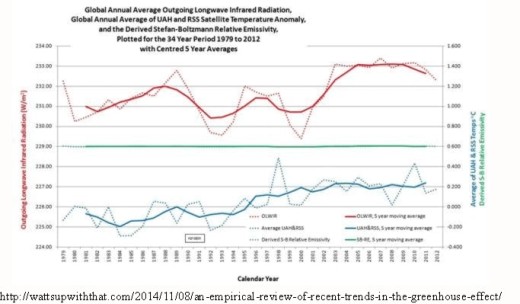
The U.S. government’s National Climate Assessment report and the UN IPCC both claim that human carbon dioxide emissions are “intensifying” the greenhouse effect and causing global warming. Let’s review claims relative to observed data.
We begin with a very simplified review of what the greenhouse effect is. Solar radiation, mostly short-wave radiation, passes through the atmosphere and warms the surface. In turn, the heated surface re-radiates energy as long-wave infrared radiation back to the atmosphere and eventually, back to space.
Greenhouse gases in the atmosphere intercept some of the long-wave infrared radiation and transfer some of the energy to excite other molecules in the atmosphere, some of the radiation goes back to the surface (this is called down-welling infrared radiation), and some of the radiation is radiated into space (this is called out-going long-wave radiation).
The carbon dioxide concentration in the atmosphere has been increasing due in part to emissions from burning fossil fuels. This increased amount of CO2 should “intensify” the greenhouse effect and cause global warming according to the National Climate Assessment and the IPCC. So, what phenomena should we observe from an “intensified” greenhouse effect?
With an “intensified” greenhouse effect, we should see a decrease in out-going long-wave infrared radiation into space. We should see warming of the atmosphere (the troposphere), a “hot spot” especially over the tropics. We should see more down-welling infrared radiation that further warms the surface. That’s the essence of the anthropogenic global warming (AGW) hypothesis. But, real-world measurements show we are seeing none of those effects.
According to satellite data compiled by NOAA, out-going long-wave radiation into space has not been decreasing but, in fact, slightly increasing (source).
Balloon-borne radiosondes and two separate satellite systems measure the temperature of the troposphere. None of these systems detect the model-predicted warming spot in the troposphere. [Source: Douglass, D.H. et al. 2007, A comparison of tropical temperature trends with model predictions, International Journal of Climatology DOI:10.1002/joc.1651].
 Finally, an independent study, published in the Journal of Climate, based on 800,000 observations, find there has been a significant decrease in down-welling, long-wave infrared radiation from increasing greenhouse gases over the 14 year period 1996-2010 in the US Great Plains. CO2 levels increased about 7% over this period and according to AGW theory, down-welling long-wave infra-red radiation should have increased over this period with buildup of carbon dioxide.
Finally, an independent study, published in the Journal of Climate, based on 800,000 observations, find there has been a significant decrease in down-welling, long-wave infrared radiation from increasing greenhouse gases over the 14 year period 1996-2010 in the US Great Plains. CO2 levels increased about 7% over this period and according to AGW theory, down-welling long-wave infra-red radiation should have increased over this period with buildup of carbon dioxide.
Empirical data show that the AGW hypothesis fails on its three major predictions. This indicates that our carbon dioxide emissions have little to no effect on global temperature nor the intensity of the “greenhouse effect” possibly because the AGW hypothesis ignores convective heat loss (weather) and other natural cycles that control the complex climate system.
There is one more failed AGW prediction: CO2 is supposed to start warming which evaporates water, a stronger greenhouse gas that will enhance warming. That should increase global humidity, but measurements show that global humidity is not increasing.
Empirical data show that the AGW hypothesis fails on four major predictions. This indicates that our carbon dioxide emissions have little to no effect on global temperature nor the intensity of the “greenhouse effect” possibly because the AGW hypothesis ignores convective heat loss (weather) and other natural cycles that control the complex climate system.
“It doesn’t matter how beautiful your theory is; it doesn’t matter how smart you are. If it doesn’t agree with experiment, it’s wrong.” – Richard Feynmann


